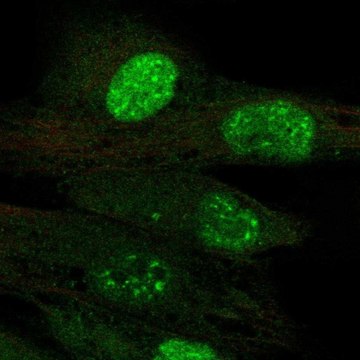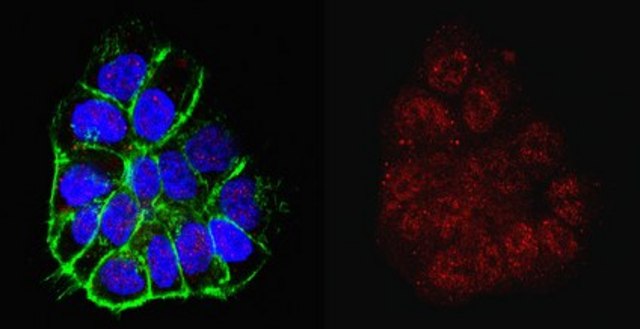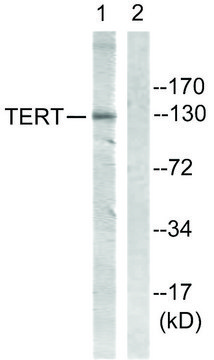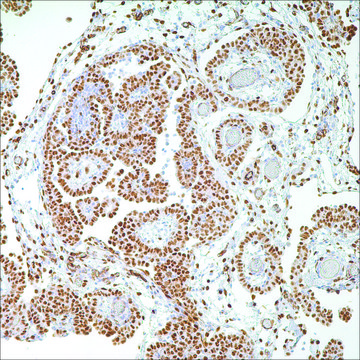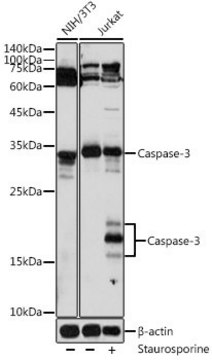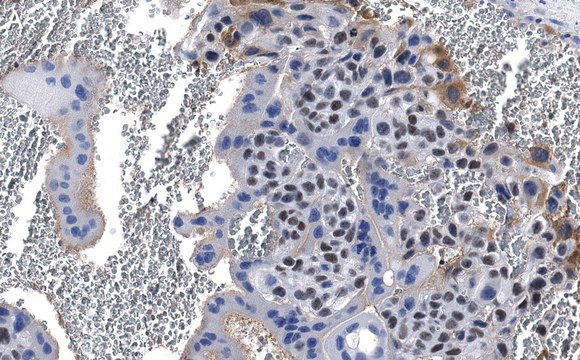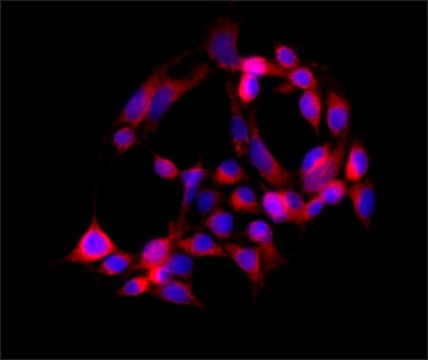推荐产品
生物来源
mouse
质量水平
抗体形式
purified immunoglobulin
抗体产品类型
primary antibodies
克隆
7D5.2, monoclonal
种属反应性
human
技术
immunohistochemistry: suitable (paraffin)
western blot: suitable
同位素/亚型
IgG2aκ
NCBI登记号
UniProt登记号
运输
ambient
靶向翻译后修饰
unmodified
基因信息
human ... TERT(7015)
一般描述
Telomerase reverse transcriptase (EC 2.7.7.49; UniProt O14746; also known as hEST2, hTRT, Telomerase-associated protein 2, Telomerase catalytic subunit, TP2) is encoded by the TERT (also known as CMM9, DKCA2, DKCB4, EST2, PFBMFT1, TCS1, TRT) gene (Gene ID 7015) in human. Telomerase reverse transcriptase (TERT) is the catalytic subunit of the telomerase responsible for adding TTAGGG repeats to the chromosome telomere ends. Cells with low or no telomerase expression lose telomere repeats during cell division, eventually resulting in cellular senescence. Most cancer cells, germ cells and embryonic stem cells express high levels of telomerase, thus contributing to pluripotency and immortality. In addition to its telomere maintenance function, telomerase also has a pro-survival role in cellular resistance against DNA damage and ensuing apoptosis. Most cancer cells are highly proliferative and express high levels of nuclear telomerase activity. Studies show that TERT shuttles from the nucleus into mitochondria upon oxidative stress induction in cancer cells. TERT mitochondrial localization helps prevent nuclear DNA damage by decreasing mitochondrial reactive oxygen species (ROS), accounting for high stress resistance especially among the cancer stem cells (CSCs) population. Following exposure to H2O2 or gamma-irradiation, cancer cells capable of excluding TERT from the nucleus display little or no DNA damage, while TERT nuclear retainment results in high DNA damage.
特异性
Clone 7D5.2 targets a sequence toward the end of the C-terminal extension (CTE) region present in spliced isoforms 1 and 3, but not in isoforms 2 and 4 of human TERT reported by UniProt (O14746).
免疫原
KLH-conjugated linear peptide corresponding to a sequence toward the end of the C-terminal extension (CTE) region of human TERT.
应用
Anti-TERT, clone 7D5.2 , Cat. No. MABE662, is a highly specific mouse monoclonal antibody that targets hTERT and has been tested in Immunohistochemistry (Paraffin) and Western Blotting.
Immunohistochemistry Analysis: A 1:50 dilution from a representative lot detected TERT in human cerebral cortex, kidney, and tonsil tissue sections.
Western Blotting Analysis: 1 µg/mL from a representative lot detected TERT in 10 µg of Jurkat cell lysate.
Western Blotting Analysis: 1 µg/mL from a representative lot detected TERT in 10 µg of Jurkat cell lysate.
质量
Evaluated by Western Blotting in PC3 cell lysate.
Western Blotting Analysis: 1 µg/mL of this antibody detected TERT in 10 µg of PC3 human prostate cancer cell lysate.
Western Blotting Analysis: 1 µg/mL of this antibody detected TERT in 10 µg of PC3 human prostate cancer cell lysate.
目标描述
~140 kDa observed. 127.0/120.0 kDa (human isoform 1/3) calculated. Uncharacterized bands may be observed in some lysate(s).
联系
Replaces: MABE14
外形
Format: Purified
Purified mouse IgG2a in buffer containing 0.1 M Tris-Glycine (pH 7.4), 150 mM NaCl with 0.05% sodium azide
其他说明
Concentration: Please refer to lot specific datasheet.
未找到合适的产品?
试试我们的产品选型工具.
储存分类代码
12 - Non Combustible Liquids
WGK
WGK 1
闪点(°F)
Not applicable
闪点(°C)
Not applicable
法规信息
新产品
我们的科学家团队拥有各种研究领域经验,包括生命科学、材料科学、化学合成、色谱、分析及许多其他领域.
联系技术服务部门